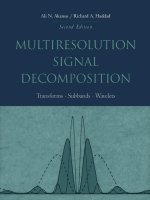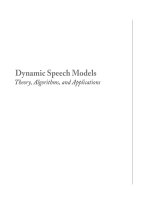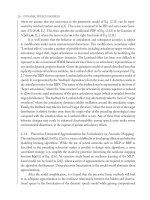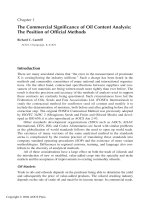Multiresolution Signal Decomposition Transforms, Subbands, and Wavelets phần 1 doc
Bạn đang xem bản rút gọn của tài liệu. Xem và tải ngay bản đầy đủ của tài liệu tại đây (2.61 MB, 50 trang )
Multiresolution
Signal
Decomposition
Transforms,
Subbands,
and
Wavelets
Second
Edition
Series
in
Telecommunications
Series Editor
T,
Russell
Hsing
Bell
Communications
Research
Morristown,
NJ
Multiresolution Signal Decomposition: Transforms, Subbands,
and
Wavelets
Ali
N.
Akansu
and
Richard
A.
Haddad
New
Jersey
Institute
of
Technology
Newark,
NJ
Other Books
in the
Series
Hseuh-Ming
Hang
and
John
W.
Woods,
Handbook
of
Visual
Communications: 1995
John
J.
Metzner,
Reliable Data Communications: 1997
Tsong-Ho
Wu and
Noriaki
Yoshikai,
ATM
Transport
and
Network Integrity: 1997
Shuo-Yen
and
Robert
Li,
Algebraic Switching Theory
and
Broadband Applications: 1999
Winston
I.
Way,
Broadband Hybrid Fiber Coax Access System Technologies:
1999
Multiresolution
Signal
Decomposition
Transforms,
Subbands,
and
Wavelets
Second
Edition
All
N.
Akansu
and
Richard
A.
Haddad
New
Jersey
Institute
of
Technology
Newark,
NJ
ACADEMIC PRESS
A
Horcourt
Science
and
Technology Company
San
Diego
San
Francisco
New
York
Boston
London Sydney Tokyo
This
book
is
printed
on
acid-free
paper.
(°°)
Copyright
©
2001,
1992
by
Academic
Press
All
rights
reserved
No
part
of
this
publication
may be
reproduced
or
transmitted
in any
form
or by any
means,
electronic
or
mechanical, including
photocopy,
recording,
or any
information
storage
and
retrieval
system,
without
permission
in
writing
from
the
publisher.
Requests
for
permission
to
make copies
of any
part
of the
work
should
be
mailed
to the
following
address: Permissions Department,
Harcourt,
Inc., 6277
Sea
Harbor
Drive,
Orlando,
Florida
32887-6777.
ACADEMIC
PRESS
A
Harcourt
Science
and
Technology
Company
525 B
Street, Suite 1900,
San
Diego,
CA
92101-4495
USA
Academic
Press
Harcourt
Place,
32
Jamestown Road, London
NW1 7BY UK
Library
of
Congress Catalog
Number:
99-68565
International
Standard Book Number: 0-12-047141-8
Printed
in the
United
States
of
America
00 01 02 03 04 EB 9 8 7 6 5 4 3 2 1
To
Bilge
and
Elizabeth
This page intentionally left blank
Contents
1
Introduction
1
1.1
Introduction
1
1.2
Why
Signal Decomposition?
2
1.3
Decompositions: Transforms,
Subbands,
and
Wavelets
3
1.3.1
Block Transforms
and
Filter Banks
4
1.3.2
Multiresolution
Structures
7
1.3.3
The
Synthesis/Analysis
Structure
8
1.3.4
The
Binomial-Hermite Sequences:
A
Unifying
Example
9
1.4
Performance Evaluation
and
Applications
9
2
Orthogonal Transforms
11
2.1
Signal Expansions
in
Orthogonal Functions
12
2.1.1 Signal Expansions
12
2.1.2
Least-Squares Interpretation
17
2.1.3
Block Transforms
19
2.1.4
The
Two-Dimensional Transformation
24
2.1.5
Singular Value Decomposition
26
2.2
Transform
Efficiency
and
Coding Performance
30
2.2.1
Decorrelation,
Energy Compaction,
and the KLT 30
2.2.2
Comparative Performance Measures
. 37
2.3
Fixed Transforms
. 41
2.3.1 Sinusoidal Transforms
, 42
2.3.2
Discrete Polynomial Transforms
55
2.3.3
Rectangular Transforms
65
2.3.4
Block Transform
Packets
70
2.4
Parametric Modeling
of
Signal Sources
71
2.4.1
Autoregressive
Signal Source Models
72
vii
viii
CONTENTS
2.4.2
AR(1) Source Model
73
2.4.3
Correlation Models
for
Images
74
2.4.4
Coefficient
Variances
in
Orthogonal Transforms
76
2.4.5
Goodness
of 2D
Correlation Models
for
Images
80
2.4.6
Performance Comparison
of
Block
Transforms
81
2.5
Lapped Orthogonal Transforms
86
2.5.1
Introduction
86
2.5.2
Properties
of the LOT 88
2.5.3
An
Optimized
LOT 90
2.5.4
The
Fast
LOT 93
2.5.5
Energy Compaction Performance
of the
LOTs
95
2.6
2D
Transform Implementation
97
2.6.1
Matrix Kronecker Product
and Its
Properties
97
2.6.2
Separability
of 2D
Transforms
99
2.6.3
Fast
2D
Transforms
101
2.6.4
Transform Applications
102
2.7
Summary
103
3
Theory
of
Subband Decomposition
113
3.1
Multirate
Signal Processing
114
3.1.1 Decimation
and
Interpolation
114
3.1.2 Polyphase Decomposition
. 123
3.2
Bandpass
and
Modulated Signals
128
3.2.1 Integer-Band Sampling
129
3.2.2
Quadrature Modulation
129
3.3
Mth
Band, Mirror,
&
Power Complementary Filters
134
3.3.1
Mth
Band Filters
134
3.3.2
Mirror
Image
Filters
135
3.3.3 Power Complementary Filters
137
3.4
Two-Channel Filter Banks
137
3.4.1 Two-Channel
PR-QMF
Bank
138
3.4.2
Regular Binary Subband Tree Structure
141
3.4.3 Irregular Binary Subband Tree Structure
146
3.4.4
Dyadic
or
Octave Band Subband Tree Structure
148
3.4.5
Laplacian
Pyramid
for
Signal Decomposition
149
3.4.6
Modified
Laplacian Pyramid
for
Critical Sampling
152
3.4.7 Generalized Subband Tree Structure
155
3.5
M-Barid
Filter Banks
156
3.5.1
The
M-Band
Filter Bank Structure
158
CONTENTS
ix
3.5.2
The
Polyphase Decomposition
161
3.5.3
PR
Requirements
for FIR
Filter Banks
170
3.5.4
The
Paraunitary
FIR
Filter Bank
. 171
3.5.5
Time-Domain Representations
180
3.5.6
Modulated Filter Banks
190
3.6
Cascaded Lattice Structures
193
3.6.1
The
Two-Band
Lossless
Lattice
194
3.6.2
The
M-Band
Paraunitary Lattice
197
3.6.3
The
Two-Band Linear-Phase Lattice
199
3.6.4
M-Band
PR
Linear
Phase
Filter Bank
203
3.6.5
Lattice Realizations
of
Modulated Filter Bank
206
3.7
IIR
Subband
Filter Banks
211
3.7.1 All-Pass Filters
and
Mirror Image Polynomials
. 213
3.7.2
The
Two-Band
IIR
QMF
Structure
216
3.7.3
Perfect
Reconstruction
IIR
Subband Systems
218
3.8
Transmultiplexers
226
3.8.1
TDMA,
FDMA,
and
CDMA Forms
of the
Transmultiplexor
227
3.8.2
Analysis
of the
Transmultiplexor
231
3.8.3
Orthogonal
Transmultiplexor
235
3.9
Two-Dimensional Subband Decomposition
236
3.9.1
2D
Transforms
and
Notation
236
3.9.2
Periodic Sequences
and the DFT 237
3.9.3
Two-Dimensional Decimation
and
Interpolation
240
3.9.4
The 2D
Filter Bank
245
3.9.5
Two-Band Filter Bank with Hexagonal
or
Quincunx
Sampling251
3.9.6
Fan
Filter Banks
258
3.10
Summary
. 259
4
Filter Bank Families:
Design
and
Performance
271
4.1
Binomial
QMF-Wavelet
Filters
. 271
4.1.1
Binomial
QMF and
Orthonormal
Wavelets
276
4.2
Maximally
Flat
Filters
278
4.3
Bernstein
QMF-Wavelet
Filters
281
4.4
Johnston
QMF
Family
286
4.5
Smith-Barnwell
PR-CQF
Family
. 286
4.6
LeGall-Tabatabai
PR
Filter Bank
289
4.7
Princen-Bradley
QMF 292
4.8
Optimal PR-QMF Design
for
Subband Image Coding
. 292
x
CONTENTS
4.8.1
Parameters
of
Optimization
. 293
4.8.2
Optimal
PR-QMF
Design: Energy
Compaction
297
4.8.3 Optimal PR-QMF Design: Extended
Set of
Variables
. . . 297
4.8.4
Samples
of
Optimal PR-QMFs
and
Performance
298
4.9
Performance
of
PR-QMF Families
304
4.10
Aliasing Energy
in
Multiresolution
Decomposition
308
4.10.1 Aliasing
Effects
of
Decimation/Interpolation
308
4.10.2
Nonaliasing
Energy Ratio
313
4.11
GTC and NER
Performance
314
4.12
Quantization
Effects
in
Filter Banks
315
4.12.1 Equivalent Noise Model
316
4.12.2
Quantization Model
for
M-Band
Codec
318
4.12.3
Optimal Design
of
Bit-Constrained,
pdf-Optimized
Filter
Banks
323
4.13 Summary
324
5
Time-Frequency
Representations
331
5.1
Introduction
331
5.2
Analog
Background—Time
Frequency Resolution
332
5.3
The
Short-Time Fourier Transform
341
5.3.1
The
Continuous
STFT
342
5.3.2
The
Discrete
STFT
343
5.3.3
ThexDiscrete-Time
STFT,
or DFT 345
5.4
Discrete-Time Uncertainty
and
Binomial Sequences
347
5.4.1
Discrete-Time Uncertainty
347
5.4.2
Gaussian
and
Binomial Distributions
350
5.4.3
Band-Pass Filters
353
5.5
Time-Frequency
Localization
355
5.5.1
Localization
in
Traditional Block Transforms
355
5.5.2
Localization
in
Uniform
M-Band Filter Banks
355
5.5.3
Localization
in
Dyadic
and
Irregular Trees
360
5.6
Block
Transform Packets
362
5.6.1 From Tiling
Pattern
to
Block Transform Packets
364
5.6.2
Signal Decomposition
in
Time-Frequency Plane
373
5.6.3 From Signal
to
Optimum Tiling
Pattern
. 376
5.6.4
Signal Compaction
380
5.6.5 Interference Excision
382
5.6.6
Summary
384
CONTENTS
xi
6
Wavelet Transform
391
6.1
The
Wavelet Transform
392
6.1.1
The
Continuous Wavelet Transform
392
6.1.2
The
Discrete Wavelet Transform
396
6.2
Multiresolution
Signal Decomposition
. 401
6.2.1
Multiresolution Analysis Spaces
, 402
6.2.2
The
Haar Wavelet
404
6.2.3
Two-Band Unitary
PR-QMF
and
Wavelet Bases
411
6.2.4
Multiresolution
Pyramid
Decomposition
, .
416
6.2.5
Finite Resolution Wavelet Decomposition
. 421
6.2.6
The
Shannon Wavelets
. 422
6.2.7
Initialization
and the
Fast
Wavelet Transform
. 425
6.3
Wavelet Regularity
and
Wavelet Families
427
6.3.1
Regularity
or
Smoothness
427
6.3.2
The
Daubechies
Wavelets
430
6.3.3
The
Coiflet
Bases
431
6.4
Biorthogonal Wavelets
and
Filter Banks
. 432
6.5
Discussions
and
Conclusion
, , 437
7
Applications
443
7.1
Introduction
443
7.2
Analysis/Synthesis Configuration
444
7.2.1
Selection
of
Analysis
and
Synthesis
Filters
. 445
7.2.2
Spectral
Effects
of
Down-
and
Up-samplers
. 446
7.2.3
Tree Structuring Algorithms
for
Hierarchical
Subbarid
Trans-
forms 447
7.2.4
Subband
Coding
.448
7.2.5
Interference Excision
in
Direct Sequence Spread Spectrum
Communications
452
7.3
Synthesis/Analysis Configuration
457
7.3.1 Discrete Multitone Modulation
for
Digital
Communications
459
7.3.2
Spread Spectrum
PR-QMF
Codes
for
CDMA
Communications
463
A
Resolution
of the
Identity
and
Inversion
473
xii
CONTENTS
B
Orthonormality
in
Frequency
477
C
Problems
479
Preface
Since
the first
edition
of
this book
in
1992
we
have witnessed
a flood of
books-
texts, monographs,
and
edited volumes describing
different
aspects
of
block
trans-
forms,
multirate
filter
banks,
arid
wavelets. Some
of
these have been mathe-
matically precise, designed
for the
rigorous theoretician, while others sought
to
interpret
work
in
this arena
for
engineers
and
students.
The field is now
mature,
yet
active.
The
theory
is
much better understood
in
the
signal
processing
community,
and
applications
of the
multiresolution
con-
cept
to
situations
in
digital multimedia, communications,
and
others abound.
In
the first
edition
and in the
early days
of
multirate
filter
banks
a
prime empha-
sis
was on
signal compaction
and
coding. Today, multiresolution decomposition
and
time-frequency concepts have opened
up new
vistas
for
further
development
and
application.
These
ideas concerning orthogonal signal analysis
and
synthesis
have
led to
applications
in
digital audio broadcasting, digital
data
hiding
and
wa-
termarking,
wireless
and
wireline
communications, audio
and
video coding,
and
many
others.
In
this edition,
we
continue
to
treat
block transforms, subband
filter
banks,
and
w
r
avelets
from
a
common
unifying
standpoint.
We
demonstrate
the
com-
monality
among these signal analysis
and
synthesis techniques
by
showing
how
the
block transform evolves
gracefully
into
the
more general multirate subband
filter
bank,
arid
then
by
establishing
the
multiresolution decomposition
features
common
to
both
the
dyadic subband tree structure
and the
orthonormal
wave-
let
transform.
In
order
to
achieve this
unification,
we
have
focused
mainly
on
orthonormal decompositions
and
presented
a
unified
and
integrate*!
treatment
of
multiresolution
signal decomposition techniques using
the
property
of
orthonor-
rnality
as the
unifying
theme.(A
few
exceptions,
such
as the
oversampled
Laplacian
pyramid
and
biorthogonal
filter
banks
are
also presented because they provide
an
historical
perspective
and
serve
as foils to the
critically sampled, orthonormal
subband
structures
we
emphasize.)
xin
xiv
Preface
Our
second
focus
in the first
edition
was the
application
of
decomposition
techniques
to
signal compression
and
coding. Accordingly,
we
describe
objcctiw
performance
criteria
that
measure this attribute
and
then compare
the
different
techniques
on
this basis.
We
acknowledge
that
subjective
evaluations
of
decompo-
sition
are
important
in
applications such
as
image
and
video processing
and
coding,
machine
vision,
and
pattern
recognition.
Such
aspects
are
treated adequately
in
the
literature cited
and are
deemed beyond
the
scope
of
this book.
A new fo-
cus
in
this edition
is the
time-frequency
properties
of
signals
and
decomposition
techniques. Accordingly, this text provides tables listing
the
coefficients
of
pop-
ular
block
transforms, subband
and
wavelet
filters, and
also their
time-frequency
features
and
compaction performance
for
both
theoretical signal models
and
stan-
dard
test
images.
In
this respect,
we
have tried
to
make
the
book
a
reference
text
as
well
as a
didactic monograph.
Our
approach
is to
build
from
the
fundamentals, taking simple
representative-
cases
first and
then extending
these
to the
next
level
of
generalization.
For
exam-
ple,
we
start with block transforms, extend these
to
lapped orthogonal
transforms,
arid
then
show both
to be
special
cases
of
subband
filter
structures.
We
have
avoided
the
theorem-proof approach, preferring
to
give explanation
and
deriva-
tions emphasizing clarity
of
concept rather
than
strict rigor.
Chapter
2 on
orthogonal transforms introduces
block
transforms
from
a
least-
squares expansion
in
orthogonal
functions.
Signal models
and
decorrelation
and
compaction
performance measures
are
then used
to
evaluate
and
compare several
proposed block
and
lapped transforms.
The
biorthogonal
signal decomposition
is
mentioned.
Chapter
3
presents
the
theory
of
perfect
reconstruction,
orthonormal
two-band
and
M-band
filter
banks with emphasis
on the finite
impulse response variety.
A
key
contribution here
is the
time-domain representation
of an
arbitrary
multirate
filter
bank,
from
which
a
variety
of
special
cases
emerge—paraunitary,
biorthog-
onal, lattice, LOT,
and
modulated
filter
banks.
The
two-channel,
dyadic
tree
structure
then
provides
a
multiresolution
link with
both
the
historical
Laplacian
pyramid
and the
orthonormal wavelets
of
Chapter
6. A new
feature
is the
rep-
resentation
of the
transmultiplexer
as the
synthesis/analysis
dual
of the
analy-
sis/synthesis multirate
filter
bank configuration.
Chapter
4
deals with specific
filter
banks
and
evaluates their objective per-
formance.
This chapter relates
the
theory
of
signal decomposition techniques
presented
in the
text
with
the
applications.
It
provides
a
unified
performance
evaluation
of
block transforms, subband decomposition,
and
wavelet
filters
from
a
signal processing
and
coding point
of
view.
The
topic
of
optimal
filter
banks
presented
in
this chapter deals with solutions based
on
practical considerations
Preface
xv
in
image coding.
The
chapter closes with
the
modeling
and
optimum design
of
quantized
filter
banks.
Chapter
5 on
time-frequency (T-F)
focuses on
joint time-frequency properties
of
signals
and the
localization features
of
decomposition tools. There
is a
discussion
of
techniques
for
synthesizing signals
and
block transforms with desirable
T-F
properties
and
describes applications
to
compaction
and
interference excision
in
spread spectrum communications.
Chapter
6
presents
the
basic theory
of the
orthonormal
and
biorthogonal
wave-
let
transforms
and
demonstrates
their connection
to the
orthonormal dyadic
sub-
band tree
of
Chapter
3.
Again,
our
interest
is in the
linkage
to the
multiresolution
subbaiid
tree
structure,
rather
than
with
specific
applications
of
wavelet trans-
forms.
Chapter
7 is a
review
of
recent applications
of
these
techniques
to
image coding,
and
to
communications applications such
as
discrete
rnultitone
(DMT) modula-
tion,
and
orthogonal spread spectrum user codes.
This
chapter links
the
riches
of
linear orthogonal transform theory
to the
popular
and
emerging transform
ap-
plications.
It is
expected
that
this linkage might spark ideas
for new
applications
that,
benefit
from
these
signal processing
tools
in the
future.
This book
is
intended
for
graduate
students
and
R&D
practitioners
who
have
a
working
knowledge
of
linear system theory
and
Fourier analysis, some linear
algebra, random signals
arid
processes,
and an
introductory course
in
digital signal
processing.
A set of
problems
is
included
for
instructional purposes.
For
classroom presentation,
an
instructor
may
present
the
material
in the
text
in
three packets:
(1)
Chapters
2 and 5 on
block transforms
and
time-frequency
methods
(2)
Chapters
3
arid
4 on
theory
and
design
of
rnultirate
filter
banks
(3)
Chapters
6 and 7 on
wavelets
and
transform applications
As
expected,
a
book
of
this
kind would
be
impossible without
the
cooperation
of
colleagues
in the field. The
paper preprints, reports,
and
private communica-
tions they provided helped
to
improve
significantly
the
quality
and
timeliness
of
the
book.
We
acknowledge
the
generous help
of N.
Sezgin
and A.
Bircari
for
some
figures.
Dr.
T.
Russell Hsing
of
Bellcore
was
instrumental
in
introducing
us to
Academic
Press.
It has
been
a
pleasure
to
work with
Dr. Zvi
Ruder during this
project.
Dr.
Eric
Viscito
was
very
kind
to
review Chapter
3. The
comments
and
suggestions
of our
former
and
current graduate
students
helped
to
improve
the
quality
of
this
book.
In
particular,
we
enjoyed
the
stimulating
discussions
and in-
teractions with
H.
Caglar,
A.
Benyassine,
M.
Tazebay,
X.
Lin,
N.
Uzun.
K.
Park.
K.
Kwak,
and
J,C.
Horng.
We
thank them all. Lastly,
we
appreciate
and
thank
xvi
Preface
our
families
for
their
understanding,
support,
and
extraordinary patience during
the
preparation
of
this book.
AM
N.
Akansu
Richard
A.
Haddad
April
2000
Chapter
1
Introduction
1.1
Introduction
In the
first
edition
of
this book, published
in
1992,
we
stated
our
goals
as
three-
fold:
(1)
To
present
orthonormal
signal
decomposition
techniques—transforms,
sub-
bands,
and
wavelets—from
a
unified
framework
and
point
of
view.
(2)
To
develop
the
interrelationships among decomposition methods
in
both time
and
frequency
domains
and to
define
common features.
(3)
To
evaluate
and
critique proposed decomposition strategies
from
a
compres-
sion
coding standpoint using measures appropriate
to
image processing.
The
emphasis then
was
signal coding
in an
analysis/synthesis structure
or
codec.
As
the field
matured
and new
insights
were
gained,
we
expanded
our
vistas
to
communications systems
and
other applications where objectives other
than
com-
pression
are
vital
— as for
example, interference excision
in
CDMA
spread
spec-
trum
systems.
We can
also represent certain communications systems such
as
TDMA,
FDMA,
and
CDMA
as
synthesis/analysis structures,
i.e.,
the
conceptual
dual
of the
compression codec. This duality enables
one to
view
all
these systems
from
one
unified
framework.
The
Fourier transform
and its
extensions have historically been
the
prime vehi-
cle
for
signal analysis
and
representation. Since
the
early 1970s, block transforms
with
real basis
functions,
particularly
the
discrete cosine transform (DCT), have
been
studied extensively
for
transform coding applications.
The
availability
of
simple
fast
transform algorithms
and
good
signal
coding performance made
the
DCT the
standard signal decomposition technique, particularly
for
image
and
video.
The
international standard
image-video
coding algorithms,
i.e.,
CCITT
2
CHAPTER
1.
INTRODUCTION
H.261,
JPEG,
and
MPEG,
all
employ DCT-based transform coding.
Since
the
recent research
activities
in
signal decomposition
are
basically
driven
by
visual signal processing
and
coding
applications,
the
properties
of
the
human
visual
system (HVS)
are
examined
and
incorporated
in the
signal
decomposition
step.
It has
been reported
that
the HVS
inherently
performs
multiresolution
sig-
nal
processing. This
finding
triggered
significant
interest
in
multiresolution
signal
decomposition
and its
mathematical foundations
in
mult
irate
signal processing
theory.
The
multiresolution signal analysis concept also
fits a
wide
spectrum
of
visual signal processing
and
visual communications applications.
Lower,
i.e
coarser,
resolution versions
of an
image
frame
or
video sequence
are
often
suffi-
cient
in
many instances. Progressive improvement
of the
signal quality
in
visual
applications,
from
coarse
to finer
resolution,
has
many uses
in
compute
1
!'
vision,
visual
communications,
and
related
fields.
The
recognition
that
multiresolution signal decomposition
is a
by-product
of
rnultirate
subband
filter
banks generated
significant
interest
in the
design
of
better-
performing
filter
banks
for
visual signal processing applications.
The
wavelet transform with
a
capability
for
variable time-frequency
resolution
has
been promoted
as an
elegant multiresolution signal processing tool.
It was
shown
that
this
decomposition technique
is
strongly linked
to
subband decompo-
sition. This linkage stimulated additional interest
in
subband
filter
banks, since
they serve
as the
only vehicle
for
fast
orthonormal
wavelet transform algorithms
and
wavelet transform
basis
design.
1.2
Why
Signal
Decomposition?
The
uneven distribution
of
signal energy
in the
frequency
domain
has
made signal
decomposition
an
important practical problem. Rate-distortion theory shows that
the
uneven spectral nature
of
real-world signals
can
provide
the
basis
for
source
compression techniques.
The
basic concept here
is to
divide
the
signal spectrum
into
its
subspectra
or
subbands,
and
then
to
treat
those subspectra individually
for
the
purpose
at
hand. From
a
signal coding standpoint,
it can be
appreciated
that
subspectra with more energy content deserve higher priority
or
weight
for
further
processing.
For
example,
a
slowly varying signal
will
have predominantly
low-frequency
components. Therefore,
the
low-pass subbands contain most
of its
total
energy.
If one
discards
the
high-pass
analysis
subbands
and
reconstructs
the
signal,
it is
expected
that
very little
or
negligible reconstruction error occurs
after
this analysis-synthesis operation.
1.3.
DECOMPOSITIONS: TRANSFORMS, SUBBANDS,
AND
WAVELETS
3
The
decomposition
of the
signal spectrum into
subbands
provides
the
mathe-
matical basis
for two
important
and
desirable features
in
signal analysis
and
pro-
cessing. First,
the
monitoring
of
signal energy components within
the
subbands
or
subspectra
is
possible.
The
subband signals
can
then
be
ranked
and
processed
independently.
A
common
use of
this
feature
is in the
spectral
shaping
of
quanti-
zation
noise
in
signal coding applications.
By bit
allocation
we can
allow
different
levels
of
quantization error
in
different
subbands. Second,
the
subband decomposi-
tion
of the
signal spectrum leads naturally
to
multiresolution signal decomposition
via
multirate
signal processing
in
accordance with
the
Nyquist
sampling theorem.
Apart
from
coding/compression
considerations, signal decomposition into sub-
bands permits
us to
investigate
the
subbands
for
contraband signals, such
as
band-
limited
or
single
tone
interference.
We
have also learned
to
think more globally
to
the
point
of
signal decomposition
in a
composite
time-frequency
domain, rather
than
in
frequency
subbands
as
such. This expansive
way of
thinking leads natu-
rally
to the
concept
of
wavelet packets
(subband
trees),
and to the
block
transform
packets introduced
in
this
text.
1.3
Decompositions:
Transforms,
Subbands,
and
Wavelets
The
signal decomposition (and reconstruction) techniques developed
in
this book
have three salient characteristics:
(1)
Orthonorrnality.
As we
shall see,
the
block
transforms
will
be
square unitary
matrices, i.e
the
rows
of the
transformation matrix
will
be
orthogonal
to
each
other;
the
subband
filter
banks
will
be
paraunitary,
a
special kind
of
orthonormal-
ity,
and the
wavelets
will
be
orthonormal.
(2)
Perfect reconstruction (PR).
This
means
that,
in the
absence
of
encoding,
quantization,
and
transmission errors,
the
reconstructed signal
can be
reassem-
bled perfectly
at the
receiver.
(3)
Critical sampling. This implies
that
the
signal
is
subsampled
at
a
minimum
possible
rate
consistent with
the
applicable Nyquist theorem. From
a
practical
standpoint, this means
that
if the
original signal
has a
data
rate
of
f
s
samples
or
pixels
per
second,
the sum of the
transmission
rates
out of all the
subbands
is
also
/
The
aforementioned
are the
prime ingredients
of the
decomposition techniques.
However,
we
also
briefly
present
a few
other decomposition methods
for
contrast
or
historical perspective.
The
oversampled Laplacian pyramid, biorthogonal
filter
banks,
and
non-PR
filter
banks
are
examples
of
these, which
we
introduce
for
4
didactic
value.
CHAPTER
1.
INTRODUCTION
(b)
Figure 1.1:
(a)
Analysis-synthesis structure;
(b)
synthesis/analysis
system.
As
shown
iri
Fig.
1.1
(a),
the
input signal
x is
decomposed
in the
analysis
section, encoded,
and
transmitted.
At the
receiver
or
synthesis section,
it is re-
constructed
as x. In a
perfect
reconstruction system
x
=
x
within
an
allowable
delay.
In a
critically sampled system,
the sum of the
data
rates
of the
decomposed
signal components equals
that
of the
input signal.
In
Fig.
l.l(b),
the
dual operation
is
shown. Typically,
the
synthesis section
could
be a
TDMA
or
FDMA multiplexer wherein several signals
are
separated
in
time (TDMA),
frequency
(FDMA),
or in
time-frequency
(CDMA),
and
com-
bined
into
one
signal
for
transmission.
The
received signal
is
then
separated
into
components
in the
analysis section.
1.3.1
Block Transforms
and
Filter Banks
In
block transform notation,
the
analysis
or
decomposition operation suggested
in
Fig.
1.1
is
done with
a
blockwise treatment
of the
signal.
The
input signal
is
first
segmented into nonoverlapping blocks
of
samples. These signal blocks
or
vectors
are
transformed into spectral
coefficient
vectors
by the
orthogonal matrix.
The
spectral unevenness
of the
signal
is
manifested
by
unequal
coefficient
energies
by
this
technique
and
only transform
coefficients
with significant energies need
be
considered
for
further processing. Block transforms, particularly
the
discrete
1.3.
DECOMPOSITIONS: TRANSFORMS,
SUBBANDS,
AND
WAVELETS
5
cosine
transforms, have been used
in
image-video
coding. Chapter
2
introduces
and
discusses block transforms
in
detail
and
provides objective performance evalu-
ations
of
known block transforms.
The
Karhunen-Loeve
transform,
or
KLT,
is the
unique
input-signal dependent optimal block transform.
We
derive
its
properties
and
use it as a
standard against which
all
other
fixed
transforms
can be
compared.
In
block transforms,
the
duration
or
length
of the
basis
functions
is
equal
to the
size
of the
data
block.
This
implies
that
the
transform
and
inverse transform
ma-
trices
are
square. This structure
has the
least possible
freedom
in
tuning
its
basis
functions.
It can
meet only
an
orthonormality
requirement and,
for the
optimal
KLT,
generate
uncorrelated
spectral
coefficients.
Limited joint time-frequency
localization
of
basis
functions
is
possible using
the
concept
of
block transform
packets (Chapter
5).
More
freedom
for
tuning
the
basis
functions
is
possible
if we
extend
the
du-
ration
of
these
functions.
Now
this
rectangular transform
or
decomposition
has
overlapping
basis functions. This overlapping eliminates
the
"blockiness"
problem
inherent
in
block transforms. Doubling
the
length
of the
basis sequences gives
the
lapped orthogonal transform,
or
LOT,
as
discussed
in
Section 2.5.
In
general,
if we
allow
arbitrary
durations
for the
basis
sequence
filters,
the
finite
impulse response (FIR)
filter
bank
or
subband concept
is
reached. Therefore,
block
transforms
arid
LOTs
can be
regarded
as
special
filter
banks.
The
rnultirate
signal processing theory
and its use in
perfect reconstruction analysis-synthesis
filter
banks
are
discussed
in
depth
in
Chapter
3.
This
provides
the
common
frame
through
which block transforms, LOTs,
and filter
banks
can be
viewed.
Figure
1.2
shows
a
hierarchical conceptual
framework
for
viewing these
ideas.
At the
lowest level,
the
block transform
is a
bank
of M filters
whose impulse
responses
are of
length
L
=
M.
At the
next level,
the LOT is a
bank
of M filters,
each
with impulse responses
(or
basis sequences)
of
length
L =
2M.
At, the top of
the
structure
is the
M-band
multirate
filter
bank
with
impulse responses
of any
length
L
>
M.
On top of
that
is the
M-band rnultirate
filter
bank with impulse
responses
of
arbitrary length
L
>
M.
This subband structure
is
illustrated
in
Fig.
1.3(a), where
the
signal
is
decomposed into
M
equal bands
by the filter
bank.
The filter
bank
often
used here
has
frequency
responses covering
the
Af-bands
from
0 to
/s/2.
When
these
frequency
responses
are
translated
versions
of a
low-
frequency
prototype,
the
bank
is
called
a
modulated
filter
bank.
The
Nyquist theorem
in a
multiband system
can now be
invoked
to
subsample
each band.
The
system
is
critically
subsampled
(or
maximally decimated)
when
the
decimation factor
D or
subsampling
parameter
equals
the
number
of
subbands
M.
When
D
<
M, the
system
is
oversampled.
6
CHAPTER
1.
INTRODUCTION
Figure 1.2:
An
overview
of
M-band
signal
decomposition.
Figure 1.3:
Multirate
filter
bank with equal
bandwidths:
(a)
M-band;
(b)
four-
band, realized
by a
two-level binary (regular) tree.
1.3. DECOMPOSITIONS: TRANSFORMS, SUBBANDS,
AND
WAVELETS
7
Another
way of
realizing
the
decomposition into
M
equal
subbands
is
shown
by
the
hierarchical two-band
subband
tree shown
in
Fig. 1.3(b). Each level
of the
tree
splits
the
preceding subband into
two
equal parts, permitting
a
decomposition into
M —
2
fc
equal subbands.
In
this case
the
M-band
structure
is
said
to be
realized
by
a
dilation
of the
impulse responses
of the
basic
two-band
structure
at
each
level
of
the
tree, since splitting each subband
in
two
dilates
the
impulse response
by
this
factor.
1.3.2
Multiresolution
Structures
Yet
another possible decomposition
is
shown
in
Fig. 1.4, which represents
a
''dyadic
tree"
decomposition.
The
signal
is first
split into low-
and
high-frequency com-
ponents
in the first
level.
This
first
low-frequency
subband, containing most
of
the
energy,
is
subsarnpled
and
again decomposed into low-
and
high-frequency
subbands. This process
can be
continued into
K
levels.
The
coarsest
signal
is
the one
labeled
LLL in the figure.
Moving
from
right
to
left
in
this
diagram,
we
see
a
progression
from
coarser
to finer
signal representation
as the
high-frequency
"detail"
is
added
at
each level.
The
signal
can
thus
be
approximately represented
by
different
resolutions
at
each
level
of the
tree.
Figure
1.4: Multiresolution dyadic
tree:
L and H
represent
low-pass
and
high-pass
filters, respectively.
An
oversampled version
of
this tree, called
the
Laplacian pyramid,
was first
in-
troduced
for
image coding
by
Burt
and
Adelson
(1983).
These topics
are
explained
in
detail
and the
reference
is
given
in
Chapter
3.
Wavelet transforms recently have been proposed
as a new
multiresolution
de-
composition tool
for
continuous-time signals.
The
kernel
of the
wavelet transform
is
obtained
by
dilation
and
translation
of a
prototype bandpass
function.
The
8
CHAPTER
1.
INTRODUCTION
discrete wavelet transform (DWT) employs discretized dilation
and
translation
parameters. Simply
stated,
the
wavelet transform permits
a
decomposition
of a
signal into
the sum of a
lower resolution
(or
coarser) signal plus
a
detail,
much
like
the
dyadic subband tree
in the
discrete-time case. Each coarse
approximation
in
turn
can be
decomposed
further into
yet a
coarser
signal
and a
detail
signal
at
that resolution. Eventually,
the
signal
can be
represented
by a
low-pass
or
coarse
signal
at a
certain scale (corresponding
to the
level
of the
tree),
plus
a sum of
detail signals
at
different
resolutions.
In
fact,
the
subband dyadic tree structure
conceptualizes
the
wavelet
multiresolution
decomposition
of a
signal.
We
show
in
Chapter
6
that
the
base
or
prototype function
of the
orthonormal
wavelet
trans-
form
is
simply
related
to the
two-band unitary
perfect
reconstruction quadrature
mirror
filters
(PR-QMF),
and
that
the
fast wavelet transform algorithm
can
also
be
strongly linked
to the
dyadic tree
filter
bank. Hence,
from
our
perspective,
we
view
wavelets
and
dyadic subband trees
as
multiresolution decomposition tech-
niques
of the
continuous-time
and
discrete-time signals,
respectively,
as
suggested
in
Fig. 1.2.
1.3.3
The
Synthesis/Analysis
Structure
figure
1.5
shows
the
dual synthesis/analysis system.
As
mentioned earlier
and ex-
plained
in
Chapter
3,
this structure could represent
any one of
several multiplexing
systems depending
on the
choice
of the
synthesis
and
analysis
filters.
Interesting
enough,
the
conditions
for
alias cancellation
in
Fig.
1.3 and for
zero cross-talk
in
Fig.
1.5 are the
same. Additionally,
the
conditions
for
"perfect reconstruction,"
x(n]
=
x(n
—
no) in
Fig.
l.l(a)
and
Xi(ri)
=
Xi(n
—
no)
in
Fig.
l.l(b),
are the
same!
Figure
1.5:
Transmultiplexer
as a
synthesis/analysis
structure









